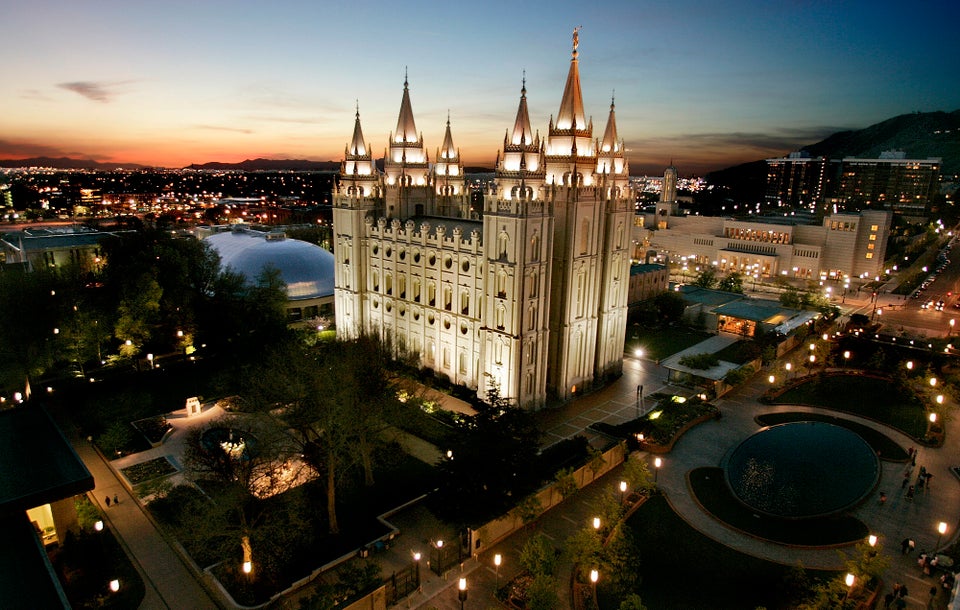
When it comes to church or temple architecture, Mormons have it all over Catholics and mega-church Protestants, whose modern churches frequently overemphasize cold, hard lines and utility.
The proposed Mormon temple at 18th and Vine Streets near the Philadelphia Parkway won't be a utilitarian warehouse. The design is one of many temple designs currently in use throughout the Mormon world. The Philadelphia temple will be the Church's 77th and it will have two spires, one hosting an image of the Angel Moroni, the angel whom, according to Mormon belief, appeared to Mormon founder Joseph Smith in Palmyra, New York, sometime after Smith asked God which church he should join.
The angel directed Smith to dig in a certain spot where he would find golden plates containing a new scripture. The translated plates became the Book of Mormon, also the name of the current Broadway hit.
The Philadelphia temple spires will reach more than 200 feet in height, providing an impressive point of reference in a sky-scape filled with crosses and steeples. The 68,000 square foot building will house a visitors' center, a family history center, a financial service office for LDS communicants and an employment services office. Renderings of the proposed structure show an eclectic mix of Greek classicism and federalist 18th and 19th century styles, the antithesis of the work of current architectural legends Frank Gehry and Zaha Hadid.
The Philadelphia design is one of the more basic temple templates, chosen from a wide range of styles in use throughout the world. The two-spire temple is in fact one of the more recognizable Mormon temple styles and will blend harmoniously with the Parkway's neoclassical structures.
Other Mormon Temple styles, such as the so called Bountiful, Front Tier, Native American Grecian or even the ultra-Disneyland-conjuring six spire temple in San Diego, have become impressive city landmarks. One of the reasons why Mormon temples become instant landmarks is because they are commonly built in isolated but high visibility sections of the city, such as near freeways. While the Center City location doesn't afford quite the isolation of a freeway ramp, the temple's Parkway presence will have a landmark feel nevertheless. The signature capstone, of course, will be the towering gilded fiberglass Angel Morni, trumpet in hand, which promises to compete with the cross atop the Catholic Basilica of Saints Peter and Paul. This juxtaposition promises to be as theologically jarring as the mix of minarets and crosses now popping up all over Western Europe.
Like Islam, Orthodox Judaism or Eastern Orthodoxy, Mormons don't want to fit in as just another denomination. The design of Mormon temples tends to reflect this view. One will always find traditional elements in Temple design; a Mormon Temple will always be recognizable as a Mormon Temple despite occasional flourishes into modernism. Mormons, in fact, seem to have a sense that too far a stretch into modernism might threaten a reinterpretation of the faith. Can a religion be altered through architecture? If it can be done through its liturgical celebrations, bricks and mortar may prove to be a powerful influence.
The temple in Mexico City, for instance, is still recognizable as "Mormon" underneath its modern Mayan design, a far cry from, say, the multi-million dollar Catholic cathedral of Our Lady of the Angels in Los Angeles, which seems to twist post-Conciliar Catholicism into a discombobulated box wreck, an appropriate symbol perhaps for a Church in crises.
Critics say that the Philadelphia Temple design contains elements of the confectionary, as if buildings built today must never hearken back to another age.
Hidden City Philadelphia, for instance, found nothing attractive about the structure.
"No one wants to discuss the appalling design of the 70 million dollar temple -- if we ignore it, it just might disappear, folks seem to say -- but it points up real tension in the decision about the role of new buildings. Should they blend in or boldly pronounce the values of our day?"
But what are the values of our day? Hidden City's criticism seems to suggest that religions update their values as the culture "progresses." After all, in a world where Yoga instructors, dog parks and weekly therapist appointments are king, how can there be anything of value in a big, gilded fiberglass angel?
The temple architect, B. Jeffrey Stebar of Perkins + Will, an Atlanta firm, is also a Mormon bishop in the Jonesboro Georgia Stake. The firm is generally noted for its Prairie-style modernism, except of course when it comes to the design of temples.
Mormon temples historically have had a heavy granite look, a carryover from the days of anti-Mormon prejudice when temples, such as the one in Nauvoo, Ill., were burned to the ground in 1848 shortly after being abandoned by Mormons heading west to Salt Lake City. Mormon Temples, according to Paul Anderson, a curator of a show on Mormon architecture at BYU, "aim for a delicate harmony between the Church's desire to appear reassuringly Christian, while at the same time proudly advertising its separation from Catholic and Protestant dogma."
Salt Lake City's Mormon Temple, perhaps the most famous in the world, was finished in 1893 (it was designed by Brigham Young's brother-in-law). A little known fact is that before its completion Church leaders made sure that it was astrologically aligned. Earlier temple designs also contain symbols you're unlikely to find in modern temples. Besides the absence of crosses, older temple models are filled with Masonic handshakes, moon phases, suns, Big Dipper Constellations, and Inverted Pentagrams. Critics of Mormonism love to point out that such symbols are proof that the religion is from "the dark side," but sometimes, as has often been said, a symbol is just a symbol.

